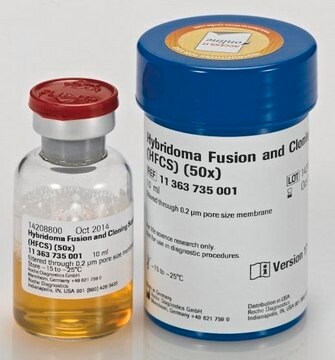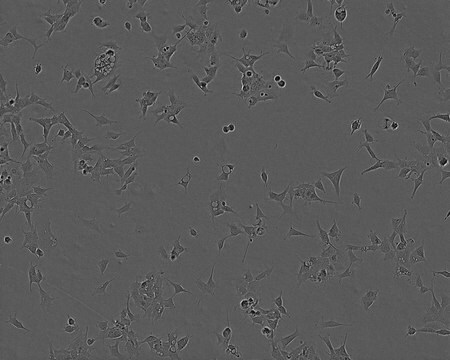SCC430
ALMC-1 Plasma Cell Myeloma Cell Line
Sinónimos:
ALMC1
Iniciar sesiónpara Ver la Fijación de precios por contrato y de la organización
About This Item
UNSPSC Code:
41106514
NACRES:
NA.81
Productos recomendados
packaging
vial of ≥1X10⁶ cells/vial mg
Quality Level
manufacturer/tradename
Millipore
growth mode
N/A
technique(s)
cell analysis: suitable
shipped in
liquid nitrogen
storage temp.
−196°C
Application
Each vial contains >1X106 viable cells.
Cells are tested negative for infectious diseases by a Human Essential CLEAR panel by Charles River Animal Diagnostic Services.
Cells are verified to be of human origin and negative for inter-species contamination from mouse, rat, Chinese hamster, Golden Syrian hamster, and Non-human Primate (NHP) as assessed by a Contamination Clear panel by Charles River Animal Diagnostic Services
Cells are negative for mycoplasma contamination.
Cells are tested negative for infectious diseases by a Human Essential CLEAR panel by Charles River Animal Diagnostic Services.
Cells are verified to be of human origin and negative for inter-species contamination from mouse, rat, Chinese hamster, Golden Syrian hamster, and Non-human Primate (NHP) as assessed by a Contamination Clear panel by Charles River Animal Diagnostic Services
Cells are negative for mycoplasma contamination.
Primary systemic amyloidosis is a plasma cell disease characterized by deposition of misfolded immunoglobulin (Ig) light chain products as amyloid fibrils throughout vital tissues and organs. Amyloidosis may present as a range of symptoms, including nervous system dysfunction, swelling, fatigue, and pain in the extremities (1). Patients with amyloidosis often suffer from other plasma cell diseases such as multiple myeloma, making the study of amyloidosis and development of potential targeted treatments extremely challenging.ALMC-1 was the first plasma cell amyloidosis cell line isolated and is characterized by c-myc amplification and deletion of the tumor suppressor p53 (2). The Ig lambda secreted by ALMC-1 cells has been shown to form amyloid fibrils in vitro (2). ALMC-1 cells proliferate in presence of IL-6, a critical factor supporting tumor growth in the bone marrow microenvironment (2). ALMC-1 cells are hypotetraploid, express CD44, and overexpress the oncogene MAFB (2). The ALMC-1 plasma cell myeloma cell line represents a valuable and clinically relevant model for amyloidosis and studies of the mechanisms of myeloma progression. SourceThe ALMC-1 cell line was isolated from bone marrow of a 50-year old female patient with amyloidosis and later diagnosed with multiple myeloma (3).References1. J Am Coll Cardiol 2016; 68(12): 1323-1341.2. Blood 112 Suppl 2008; 1: 2732a-2832a.3. Cancer Res 1993; 53:5320-5327.
Features and Benefits
The ALMC-1 plasma cell myeloma cell line is a clinically relevant model for amyloidosis and studying the mechanisms of myeloma progression.
Storage and Stability
The cells should be stored in liquid nitrogen. The cells can be cultured for at least 10 passages after initial thawing without significantly affecting the cell marker expression and functionality.
Other Notes
This product is intended for sale and sold solely to academic institutions for internal academic research use per the terms of the “Academic Use Agreement” as detailed in the product documentation. For information regarding any other use, please contact licensing@emdmillipore.com.
Disclaimer
RESEARCH USE ONLY. This product is regulated in France when intended to be used for scientific purposes, including for import and export activities (Article L 1211-1 paragraph 2 of the Public Health Code). The purchaser (i.e. enduser) is required to obtain an import authorization from the France Ministry of Research referred in the Article L1245-5-1 II. of Public Health Code. By ordering this product, you are confirming that you have obtained the proper import authorization.
Unless otherwise stated in our catalog or other company documentation accompanying the product(s), our products are intended for research use only and are not to be used for any other purpose, which includes but is not limited to, unauthorized commercial uses, in vitro diagnostic uses, ex vivo or in vivo therapeutic uses or any type of consumption or application to humans or animals.
Related product
Referencia del producto
Descripción
Precios
Storage Class
10 - Combustible liquids
wgk_germany
WGK 2
flash_point_f
Not applicable
flash_point_c
Not applicable
Certificados de análisis (COA)
Busque Certificados de análisis (COA) introduciendo el número de lote del producto. Los números de lote se encuentran en la etiqueta del producto después de las palabras «Lot» o «Batch»
¿Ya tiene este producto?
Encuentre la documentación para los productos que ha comprado recientemente en la Biblioteca de documentos.
Nuestro equipo de científicos tiene experiencia en todas las áreas de investigación: Ciencias de la vida, Ciencia de los materiales, Síntesis química, Cromatografía, Analítica y muchas otras.
Póngase en contacto con el Servicio técnico



